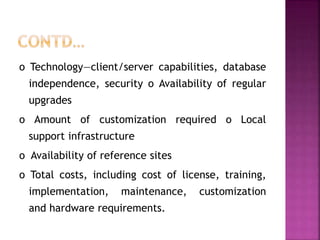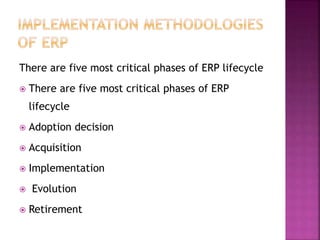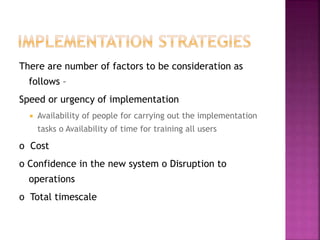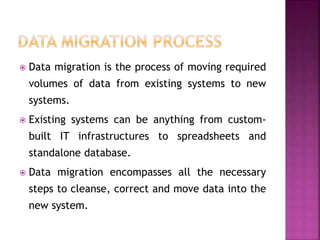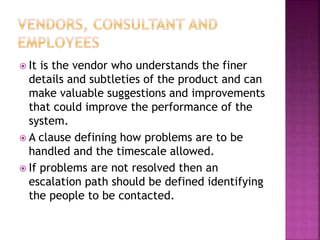Enterprise Resource planning Unit 3 ERP implementation
- 1. Prepared and presented by, N. Ganesha Pandian, Assistant professor, Madurai School of management. IIyearIIISemester Academicyear2017-2018 1
- 2. Personnel Technology Workflow Performance Measurements
- 3. A review of the potential software products that are a “fit” for the organization’s environment Elimination of those packages that do not meet the specified needs and requirements Creation of a manageable list of vendors for final review – typically three to five Scheduled detailed product demonstrations A check of your vendor’s references A visit to a “like” customer site of the final short-listed vendors
- 4. The different phases of the ERP implementation are given below: Pre-evaluation Screening Package Evaluation Project Planning Phase Gap analysis Re-engineering Configuration Implementation Team Training Testing Going Live End-user Training Post-implementation.
- 5. According to S Shankarnarayanan, Senior Consultant with Baan Info systems India Pvt. Ltd. (ERP Systems—Using IT to gain a competitive advantage), some important points to be kept in mind while evaluating ERP software include: o Functional fit with the company’s business processes o Degree of integration between the various components of the ERP system o Flexibility and scalability o Complexity o User friendliness o Quick implementation o Ability to support multi-site planning and control
- 6. o Technology—client/server capabilities, database independence, security o Availability of regular upgrades o Amount of customization required o Local support infrastructure o Availability of reference sites o Total costs, including cost of license, training, implementation, maintenance, customization and hardware requirements.
- 7. There are five most critical phases of ERP lifecycle There are five most critical phases of ERP lifecycle Adoption decision Acquisition Implementation Evolution Retirement
- 8. There are number of factors to be consideration as follows – Speed or urgency of implementation Availability of people for carrying out the implementation tasks o Availability of time for training all users o Cost o Confidence in the new system o Disruption to operations o Total timescale
- 9. ERP implementation is primarily a people project. Training is perhaps the most misjudged activity of implementation life cycle. One of the most common mistake of all ERP implementations is understanding the time and cost of training program is done.
- 10. Experts say that the technical training of the core team of people who are installing the software is done properly and there is no problem in that aspects. Many studies have revealed the fact that as few as 10-15% of ERP implementations have a smooth introduction that delivers the anticipated benefits.
- 11. Pre implementation Training User Training (During and after Implementation) Training, Assessment and Review
- 12. Data migration is the process translating data from one format to another. Data migration is necessary when an organization decides to use a new computing system or database management system that is incompatible with the current system. Data migration is performed by a set of customized programs or scripts that automatically transfer the data.
- 13. Data migration is the process of moving required volumes of data from existing systems to new systems. Existing systems can be anything from custom- built IT infrastructures to spreadsheets and standalone database. Data migration encompasses all the necessary steps to cleanse, correct and move data into the new system.
- 14. Electronic Method Manual Method
- 15. Question that need to be addressed – What data is required on the new system? Can this data be transferred from the old system? What data is required that is not on the old system? Does this data exist elsewhere and how can it be best input? Who will check the data and when? Who will input the data and when?
- 16. Chief Executive Officer (CEO) Executive Committee External Consultant Project Manager )Project Management Team Work Teams or Implementation Teams Technical Support Team Administrative Support team
- 17. It is the vendor who understands the finer details and subtleties of the product and can make valuable suggestions and improvements that could improve the performance of the system. A clause defining how problems are to be handled and the timescale allowed. If problems are not resolved then an escalation path should be defined identifying the people to be contacted.
- 18. Consultants are responsible for administering each of the phases of the implementation so that the required activities occur at the scheduled time and at the desired level of quality and with effective participation of all those who must participate. In order to keep the promises that they have made during the negotiations, the consultants have to transform their approaches and methodologies into detailed work plans.
- 19. The project manager should monitor and control the costs incurred by the vendor. It is possible to monitor consultancy costs, which is a potential area for overspend, by monitoring the time that the vendor’s personnel are in-site. Mistakes do happen and it is advisable that vendor’s invoices are checked.






